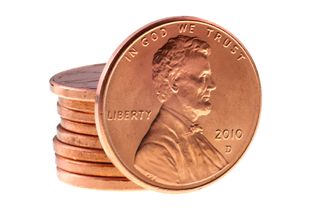How to Make the Penny Have Value Again
How to Make the Penny Worth 1 Cent Again

Inflation and the rising price of metals have combined to put the United States in the rather silly position of minting pennies and nickels that cost more than their face values to make. Minting one penny currently costs 2.4 cents, and one nickel, 11.2 cents.
Some people advocate wriggling out of this spot by eliminating the penny altogether, and giving a long hard look at the nickel, too. But others believe we must spare the spare change in order to prevent jarring the economy. President Barack Obama proposed an alternative solution in his 2012 budget: He wants the U.S. Mint to investigate ways of making pennies and nickels from less expensive materials, which he hopes could save up to $100 million per year.
This is indeed a possibility.
The penny was originally made of pure copper, but since 1982, it has been wrought of 97.5 percent zinc, a much cheaper metal, surrounded by a thin copper skin. Simply making the copper skin thinner would not save much money, as most of the penny's price hike has resulted from the rising cost of zinc, said Robert Pike, a chemistry professor at the College of William and Mary. At 91 cents per pound, zinc is cheaper than copper, which costs $3.80 per pound — but it isn't cheap enough. [Where'd that Bridge Go? The Weirdest Metal Thefts]
"The obvious strategy would be to go to an even cheaper metal," Pike said. "During World War II, pennies were briefly made from zinc-coated steel. These were circulated." Steel currently costs around 36 cents per pound. Switching from zinc to steel would thus reduce the production cost of the penny well under one cent, even if the coin's copper cladding were retained for consistency.
As for nickels, they contain 75 percent copper and 25 percent nickel. "For the nickel, once again the solution is a matter of debasing. Perhaps the 75 percent copper in the nickel could be partially or fully replaced with zinc," Pike told Life's Little Mysteries.
Alternatively, the cores of both pennies and nickels could be made of something entirely nonmetallic. Plastic is inexpensive and would be a good option from a production standpoint, Pike said, but it wouldn't work for other reasons. "Debasement of currency is a matter of public perception as well as actual value. It seems to me that the public wouldn't accept a lightweight penny that is easily exposed as being made of plastic."
A much better option for a core with similar heft as zinc would be some sort of ceramic material. "Ceramics are metal-based and therefore much heavier than plastic, albeit not as heavy as metal itself. Ceramics could be made from silica (SiO2) and alumina (Al2O3)," — both inexpensive — "perhaps with a bit of heavier oxide such as [titanium oxide] added for weight," he said. "The ceramic penny core presumably could be anodized with a copper skin fairly cheaply."
So, if a change in our change would be easy to do, what's the holdup?
Two main issues: First, switching the production setup at the U.S. Mint will require a cash injection, though the decrease in material costs means the alteration would quickly pay for itself. More importantly, "One of the concerns with altering coin compositions has to do with how vending machines recognize them," Pike said.
If pennies and nickels literally become "loose change" — if they contain metals or ceramics with lower densities than zinc — they might not register in machines.
This article was updated 2/17 at 2:15 p.m. to correct the chemical composition of modern nickels.
Follow Natalie Wolchover on Twitter @nattyover. Follow Life's Little Mysteries on Twitter @llmysteries, then join us on Facebook.
Source: https://www.livescience.com/18528-penny-worth-1-cent.html

0 Response to "How to Make the Penny Have Value Again"
Post a Comment